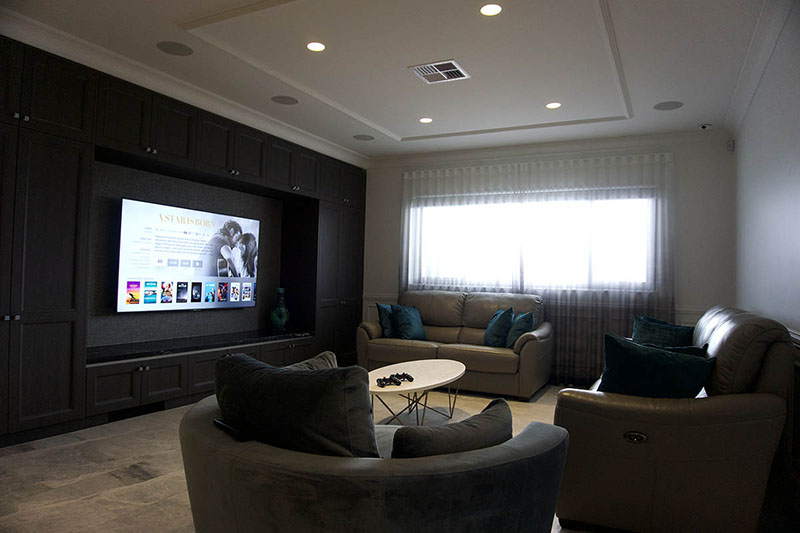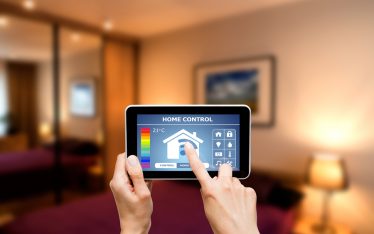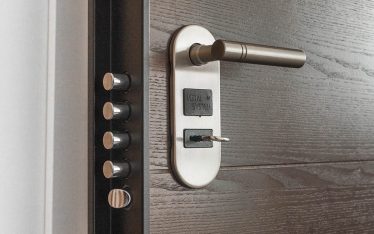Smart home theatre is gaining popularity, transforming home entertainment and providing family homes with a true cinema experience.
The internet is full of smart home theatre ideas on social media sites like Pinterest and Instagram, with people showing off their unique home theatre set-ups. While some people spend money having professional, smart technology integrators set up their smart home theatre, others have successfully gone the DIY route; a growing trend.
The team here at SmartHomeWorks are experts at smart home theatre installation. We have put together this guide to give you a step-by-step plan outlining the steps required to set up a smart home theatre with a professional finish. Read on to learn more.
Make a plan
The first thing to do is get a plan together. Knowledge is power, so it may be worth researching online, watching installation videos and learning how smart home theatre systems are set up.
Choose a room and map out where you want your home theatre to be. Then, take measurements and start drawing up a blueprint. You must think and plan like a trade professional to achieve a professional finish.
Build your frame and insulate
Assuming you have conducted all demolition or prep work required, the first step in construction is to build your wall frames and insulate them.
Not only do you need insulation for heating and cooling, but also to provide added soundproofing, which keeps sound from escaping the room; good for the people watching the movie and the other occupants who may want some peace and quiet.
Pre-wire for all your components
Before sealing up your walls and ceiling, getting everything pre-wired and ready to connect is a good idea. This is how professional installers work, and it will save you hours or potentially days of work using wire pullers through holes in your drywall.
You should include this in the planning stage and know where your audio-visual equipment, like video and speakers, are going.
If you are running mains power wiring and new power points, you will need to hire a qualified electrician to perform this part of the smart home theatre installation. Performing DIY mains power installation is illegal in Australia. It is also incredibly dangerous and potentially fatal.
Many current smart home theatre systems run on wireless systems, like Bluetooth, reducing the amount of pre-wiring required. However, many home theatre enthusiasts still swear by wired systems for sound quality and reliability; this is often a personal choice and worth further investigation.
Projector screen or Smart TV?
Something else you need to be clear on in the planning stage is if you plan on installing a projector and projector screen, a large smart TV, or both.
Many home theatres are used for multi-use entertainment; this has prompted many homeowners to install a drop-down projector screen that covers their Smart TV for movies and retracts into a housing or the ceiling when someone is using a gaming console or streaming through services like NetFlix or Disney+.
If you are using a projector only and plan on installing a permanent projector screen, this will be one of your final components to install. However, if you are installing a smart TV or retractable projector screen, you will need to run the wiring at this stage.
Accessories and appliances
Think hard about all the appliances you may want to include in your home cinema, including systems you plan on using in the future; best to have as much preparation in place as possible to avoid difficult future installations.
This could include appliances such as:
- Blu-ray
- Painted or hung projector screen
- Streaming device
- Gaming console
- Home theatre PC
- Voice command modules
- Audio receivers
- Record players and more
Once the walls are closed in with drywall, adding technology becomes significantly more difficult, so best get everything in now, even if that means you have to hide some unused wires for a while—future-you will be thankful.
Lighting
Mood lighting is essential to set the tone of your home theatre. If you plan to install a custom lighting system, you will need to get your electrician to wire these points. The electrician may have to return after you have closed in the walls and ceiling to wire up new switches, power and data points.
Speakers
How you pre-wire for your speakers depends on whether you have selected to install a 5.1 or 7.1 surround system.
5.1 Surround sound
A 5.1 surround sound typically features a centre and a front and rear set-up, meaning five speakers. Point one in 5.1 refers to the subwoofer.
7.1 Surround sound
As you may have calculated, a 7.1 surround sound features the same five speakers and subwoofer as a 5.1 system but also includes a direct left and right speaker to create an all-encompassing surround sound experience.
Install drywall and sound barriers
Once all insulation and wiring are installed, and the wires are in place, you are ready for their final fittings; it’s time to:
- Close in and fasten the drywall
- Glue cornices
- Seal and fill gaps
- Sand and paint
You may even choose fancy wallpaper or install curtained walls like a real cinema. Once the paint has dried, or the wallpaper has set, you can also put up any sound-dampening panels you have created to improve sound quality.
Now your smart home cinema should be taking shape. We suggest leaving the seating till last, and installing the hardware first, so you have plenty of room to move around.
Install your smart home theatre and video systems
This is the part of your home theatre integration where all the hard work pays off, and all that pre-wiring makes sense.
Start at the wall and work your way back, installing all components, such as:
- Smart TV
- Projector screen
- Blu-ray
- Streaming device
- Gaming console
- Home theatre PC
- Projector and other components
Perform neat cable management as you go; this will keep a tidy professional finish that you will be proud of every time you look at all your hard work.
Adding the finishing touches to your smart home theatre
Now it’s time to add furniture and any finishing touches you have decided on to give your smart home theatre its feature comforts. Examples could include:
- Reclining chairs
- Bean bags
- Tables
- Mini bar or fridge
- Rugs
- Artwork and more
While creating a DIY smart home theatre is not out of reach for most people, it may be too big a project for others. If this sounds like you, you may want to consider hiring a professional.
The smart home integrators here at SmartHomeWorks are industry leaders for smart home theatre installation across Sydney and Australia’s East coast. For more information about our smart home theatre installation solutions, call (02) 8197 1133, or send your inquiries via email to design@smarthomeworks.com.au.






